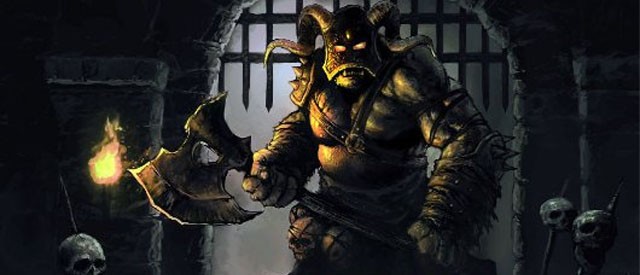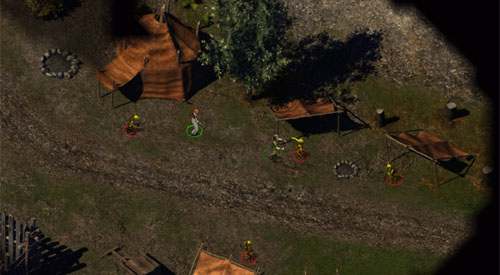

The reason you’re probably reading this review is because you’re either wondering if Baldur’s Gate: Enhanced Edition (henceforth BG:EE) is either 1) worth replaying if you’ve played the original, or 2) it's worth playing for the first time if you didn’t play the original. Since BG:EE is actually my first foray with the game, to the former group I can only relate what is different about the Enhanced Edition, which is a good place to start in any case.
BG:EE offers an impressive amount of updates to the game. Perhaps the most immediately noticeable is the updated Infinity engine for the game as well as high resolution and widescreen support. The interface has also been updated visually (but I believe it still functions much the same as the original). BG:EE comes complete with the original game as well as its expansion, Tales of the Sword Coast. A brand new adventure, the Black Pits, has been added as have three brand new companion characters. Also, aspects from Baldur’s Gate II have been brought over, such as class kits, new subraces and subclasses. On top of that, a whopping 400 issues with the original game were addressed during the process of updating it. It’s certainly worthy of the title “Enhanced Edition.”

While knowing the additions and updates from the original to the enhanced edition is probably enough to help former players decide whether they want to purchase it or not, they don’t tell a brand new player how the game actually plays. The rest of my review is mostly geared to new players of Baldur’s Gate, whether it be original or enhanced.
The game pretty much plays the same in single-player as co-op, so this review will be defaulting to a co-op experience. Setting up a game is relatively simple: one player will host by choosing from either the Baldur’s Gate campaign or the Black Pits. Through navigating the menu, it just takes a few seconds to set up a multiplayer game. Currently, only TCP/IP is supported (online matchmaking is in the works), so players will need to get the host’s IP address to connect. This means that you will need to know people who have the game in order to play it in co-op. Make sure to open UDP 47630 via port forwarding on your router. From the lobby, the host can set permissions for each individual player (e.g. allow players to perform dialogue options, pause, etc.) and designate the six character slots to players. No matter how many players are connected to a game, the max party size is six characters, so be sure to divide those slots accordingly. Once everyone is ready, they just have to check the large gold check box next to each of their characters. When all characters have their ready indicator checked, the host can start the game.
For newcomers to the game, let me just make one thing clear: BG:EE is not an easy game. Party composition is important (for example, creating a party of six mages is probably a good way to cause you to rage quit in five minutes) as are tactics. If it’s been a long time since you’ve played a game like BG:EE, I’d strongly recommend going through the tutorial (which is only available in single-player). Many of the basics of the gameplay are explained in it. Many are not, and you’ll have to learn them on the fly or use the internet when you have questions. BG:EE is not a game you can Dynasty Warriors your way through. The pause button is your friend. You may even spend more time with the game on pause than not as you figure out your next move. I spent a ridiculous percentage of time talking to my co-op partner (who was conveniently in the same room) about what the plan was, and the exact course of action my character(s) were going to take as soon as the game resumed (e.g. “My cleric’s going to heal your warrior now. Save your druid’s heal.”).
On a similar note, save often. You never know when all hell’s going to break loose suddenly and you’ll end up dead. If the main character (which I believe is just character slot 1 when you first create a brand new game) dies, it’s game over. All other characters can die and be resurrected at a temple for a fee. It took me way too long to learn this. However, you do have to carry all their stuff back to town and be down a party member until you get there. Due to this, you’ll probably elect to reload the game and try the fight again. If this pause-and-play, save often, and retry-by-reloading gameplay doesn’t sound fun to you, then BG:EE may not be the game for you. Similarly, you may want to be sure the people you plan to play with are on the same page as far as playstyle goes.
It might sound like I’m coming down in BG:EE. That’s absolutely not the case. I still play Bioware’s modern RPG Dragon Age in a very similar style to BG:EE. I love the tactical decision making and figuring out the best ways to execute a fight. I love figuring out a great party composition. The fact that BG:EE allows me to do this in co-op is absolutely great for me. There’s a certain sense of achievement one gets from executing a difficult fight well. For me, that’s a huge part of BG:EE. There’s also a strong story and side quests (which I won’t spoil, since that’s a huge part of the experience), not to mention the memorable characters. Keep in mind that recruiting any of the in-game characters forces the host to kick out an existing character, so make sure to check if it’s okay to replace a character with your co-op partners.
The Black Pits is the new adventure to BG:EE. The general gameplay is the same as the campaign in co-op, but it’s more about fighting and less about story. The insane drow Baeloth has kidnapped six heroes to fight in his underground arena to the death. It’s an arena set-up, where players will have to fight a certain group of enemies in the arena, and then they can come back to a room to buy and sell. Any dead characters will be revived upon re-entering this safe room. It should be noted that leveling is much quicker at the beginning than in the campaign (and you’re given a lot of gold to buy gear), so the Black Pits might be a good place to start when getting the hang of the gameplay.
My biggest complaint with the game was the interface. While certainly no fault of Overhaul Games (the team behind the Enhanced Edition), the system of using spells and attacking feels very outdated. And after 14 years, it’s no wonder. There are no real hotkeys for skills, so every character must be targeted and then their spells list must be opened, and then from there a spell can be cast. Some non-spell skills (like hide in shadows) are placed on the main bar, so those can be clicked, and one can quickslot a couple of spells (but only a couple), but it’s a bit of frustrating menu navigation that modern games have done away with for a more fluid experience. It’s really just a small thing, though - mostly an annoyance.
In sum, BG:EE is a great RPG experience if you can forgive some small annoyances due to age, like the interface. It’s very different than modern RPGs, in that it’s a tactical game, so it’s not going to be for everyone. A great amount of patience and planning will be required of most players. The co-op experience is solid, as it offers all the perks of the the full game, but with friends. The additions they’ve made to the original game are also solid, and clearly haven’t just been tacked on. The Black Pits provides a nice setting for players who might not be able to dedicate very much time to their gaming sessions as well as an opportunity for new players to adjust to the gameplay. There’s a good amount of replayability as well for new and old players alike, as you can always go back and try a new party. It’s a solid purchase for old school RPG fans, but definitely don’t go in expecting anything resembling a modern RPG or you’ll only be frustrated with what you find.
The Co-Optimus co-op review of Baldur's Gate Enhanced Edition is based on the PC version of the game. A copy of the game was provided by the publisher.